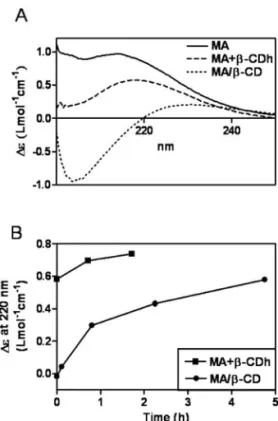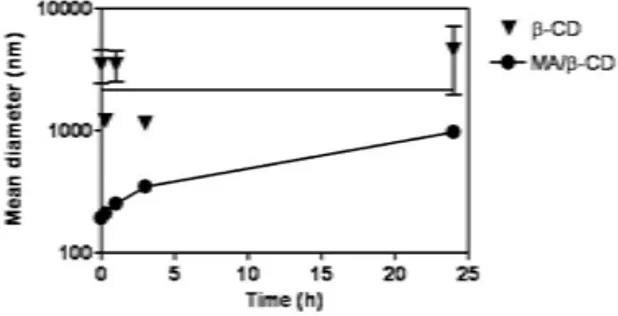Brazilian Journal of Physics, vol. 39, no. 1A, April, 2009 223
Physicochemical Characterization of Orally-Active Meglumine Antimoniate/Beta-Cyclodextrin
Nanoassemblies: Non-Inclusion Interactions and Sustained Drug Release Properties
P. S. Martins, R. R. Ribeiro, A. P. C Bahia, R. L. M. Neto, F. Fr´ezard∗
Departamento Fisiologia e Biof´ısica, Instituto de Ciˆencias Biol´ogicas, Universidade Federal de Minas Gerais, Av. Antˆonio Carlos 6627, Pampulha, 31270-901 Belo Horizonte, MG, Brazil
A. M. C. Pimenta
Departamento Bioqu´ımica-Imunologia-ICB, Universidade Federal de Minas Gerais, Brazil A. L. Melo
Departamento Parasitologia-ICB, Universidade Federal de Minas Gerais, Brazil L. Le Moyec
CNRS 7033, Universit´e Paris XIII, France C. Demicheli
Departamento Qu´ımica-ICEX, Universidade Federal de Minas Gerais, Brazil (Received on 1 July, 2008)
β-cyclodextrin (β-CD) is widely used as a component of pharmaceutical formulations, classically to improve the solubility and oral bioavailability of poorly water-soluble drugs through formation of drug/β-CD inclusion complexes. Unexpectedly, the association of the highly water-soluble drug meglumine antimoniate (MA) with
β-CD turned this antimonial compound orally-active in a murine model of leishmaniasis. To get insight into the mechanisms responsible for the enhanced oral efficacy of MA, the MA/β-CD composition was characterized physicochemically, using thermogravimetry, circular dichroism, mass spectrometry (ESI-MS), osmometry and photon correlation spectroscopy. The freeze-dried MA/β-CD was found to form nanoassemblies in water, as a result of multiple non-inclusion interactions between MA andβ-CD, which behave as a sustained release system of the MA drug.
Keywords: cyclodextrin, antimony, meglumine antimoniate, sustained release, nanobiotechnology
I. INTRODUCTION
Even though the pentavalent antimonials meglumine anti-moniate (MA) and sodium stibogluconate are still the first-line drugs against all forms of leishmaniasis, their use in the clinical setting shows several limitations. These compounds have to be given parenterally, daily, for at least 4 weeks. An-timony therapy is often accompanied by local pain during in-tramuscular injections and by severe systemic side effects, re-quiring very careful medical supervision. The appearance of drug resistance is another important problem in the treatment of this disease. All these factors contribute to compliance dif-ficulties and treatment failures.
The search for an orally-active formulation of MA led us to prepare and evaluate a composition comprising MA andβ -cyclodextrin (β-CD). Even though hydrophilicβ-CD is not expected to enhance the absorption of water-soluble (BCS class III) drugs by the oral route, the MA/β-CD composition rendered MA orally active in a murine model of cutaneous leishmaniasis [1]. This unexpected result was attributed, in part, to the fact that the heating of equimolar mixture of MA andβ-CD (first step of preparation of MA/β-CD composi-tion) induced the depolymerization of MA from high molec-ular weight Sb complexes into 1:1 Sb-meglumine complex, resulting in an enhanced oral bioavailability of Sb [2]. Since the pre-heated MA+β-CD mixture still produced significantly
∗Electronic address:frezard@icb.ufmg.br
lower serum Sb levels when compared to the MA/β-CD com-position [2], we inferred that the freeze-drying process (sec-ond step of preparation of MA/β-CD composition) was re-quired for achieving a high absorption of Sb by oral route.
The aim of the present work was to get insight into the physicochemical alterations induced by the freeze-drying step, through characterization of MA/β-CD composition by circular dichroism, mass spectrometry (ESI-MS), osmometry, thermogravimetry and photon correlation spectroscopy.
II. EXPERIMENTAL METHODS
II.1. Samples preparation
The MA/β-CD composition was prepared by mixing β -CD and the 1:1 SbV-megumine complex in water at a 1:1 β-CD/Sb molar ratio, heating the mixture for 48 h at 55oC under stirring and finally freeze-drying the resulting solution.
II.2. Physicochemical analyses
224 P. S. Martins et al.
mol/L of Sb) MA solution. MA+CDh: pre-heated MA+β-CD obtained from the dilution in water of an equimolar MA+β -CD mixture at 0.05 mol/L Sb previously heated for 48 h at 55oC under stirring.
In the photon correlation spectroscopy analysis (ZEN3500, Malvern Instruments), lyophilized samples were prepared in deionized water at the final β-CD concentration of 2.5 mmol/L and kept at 25oC. The mean hydrodynamic diame-ter and polydispersity index were dediame-termined different times after the preparation of the solution.
In the osmometry experiment, MA and MA/β-CD were prepared at 0.04 mol/L Sb in water from the lyophilized sam-ples; solutions were kept at 25oC and osmolarity was mea-sured immediately and at different time intervals after disso-lution (freezing point osmometer,µOSMETTE Model 5004, Precision Systems Inc.).
The circular dichroism signal is given as ∆ε, which is the differential molar dichroic absorption coefficient (∆ε = εL −εRin Lcm−1mol−1)and is expressed in terms of the molar concentration of Sb.
Sb-meglumine complex ions were easily characterized by ESI-MS as containing Sb by the distinctive isotope pattern of Sb (ratio of121Sb:123Sb, 57:43). Each species is indicated in the following with them/zvalue of the first peak of its isotopic cluster.
III. RESULTS AND DISCUSSION
FIG. 1: A: circular dichroism spectra of different compositions of MA, just after preparation in water at 0.01 mol/L Sb at 25 ˚ C. B: kinetics of change of circular dichroism signal at 220 nm.
Figure 1A shows the circular dichroism spectra obtained for MA, MA+β-CDh (pre-heated MA+β-CD) and MA/β-CD (lyophilized MA+β-CD), immediately after their preparation
in water at 0.01 mol/L Sb and 25oC. As reported previously [2], upon heating of MA in the presenceβ-CD, the circular dichroism spectrum of MA shows a decrease of its inten-sity and a red-shift, as a result of the formation of a ternary meglumine-Sb-β-CD complex. Strikingly, following submis-sion of the heated MA+β-CD mixture to freeze-drying, MA spectrum suffered marked changes, with the appearance of a negative Cotton effect centered at 205 nm, indicating the oc-currence of additional interactions between MA andβ-CD.
When the circular dichroism spectrum of MA/β-CD com-position was registered as a function of time, it was found to return slowly to a spectrum characteristic of MA (Fig. 1B), indicating that the MA/β-CD composition released MA. The kinetic was found to be biphasic with a first rapid phase and a slow late phase.
FIG. 2: Time-course of variation of the osmolarity of MA and MA/β-CD solutions at 25 ˚ C, just after the dissolution of lyophilized compounds in water at 0.04 mol/L of Sb.
When the osmolarity of MA and MA/β-CD solutions was measured as a function of time, just after the dissolution of these compounds in water at 0.04 mol/L of Sb, a slow increase of the osmolarity was observed in both cases (Fig. 2), indicat-ing the occurrence of a slow dissociation of high molecular weight species into low molecular weight ones. The increase of osmolarity of MA solution as a function of time was re-ported previously and attributed to the hydrolysis of the more polymerized complexes into 1:1 Sb-meglumine complex [3]. Strikingly, the increase of osmolarity of MA/β-CD solution during 96 h was greater than that of MA solution (44 mosM vs 28 mosM), supporting the hypothesis that MA/β-CD com-plexes also slowly dissociate.
Thermogravimetry analysis of MA/β-CD composition in-dicated the presence of 9 water molecules per Sb atom, sug-gesting that β-CD did not release originally included water molecules [4] into the bulk water upon association with MA and that non-inclusion interactions are taking place.
TABLE I: Sb-β-CD complexes identified by ESI(-)-MS in the MA/β-CD composition
Sb-β-CD complexesa m/z
[β-CD(NMG)(Sb)2(OH)4– 8H]2− 816
Brazilian Journal of Physics, vol. 39, no. 1A, April, 2009 225
Table 1 displays the main anionic species identified by ESI(-)-MS in MA/β-CD and their proposed structural for-mula. The formation of 1:2:1, 2:2:1 and 2:2:2 meglumine-Sb-β-CD complexes is proposed. When compared to the ternary 1:1:1 meglumine-Sb-β-CD complex previously identified [2], these new species exhibit higher molecular weight and ion-ization state, presumably as a result of multiple associations. Comparing the ESI(-)-MS spectra of MA/β-CD, immediately and 24 h after its dissolution in water, indicated a decrease of the relative abundance of these species, suggesting that some of these species may contribute to the enhanced absorption of Sb by oral route.
FIG. 3: Time-course of variation of the mean hydrodynamic diam-eter of particles after reconstitution of MA/β-CD orβ-CD in water, as determined by photon correlation spectroscopy.
Figure 3 shows the time-course of variation of the mean
hydrodynamic diameter of particles, as determined by photon correlation spectroscopy, after reconstitution of MA/β-CD or β-CD in deionized water at 2.5 mmol/L ofβ-CD.
Initially, a mean hydrodynamic diameter of 190 nm with a polydispersity index of 0.37 was measured. The mean hydro-dynamic diameter was found to increase as a function of time. From 0 to 3 h, the increase in particle size was accompanied by a decrease of the particle count. At 24 h, a mean diameter of 971 nm was registered with a polydispersity index of 0.75. Whenβ-CD alone was studied, lower particle counts were ob-served, mean hydrodynamic diameters higher than 1000 nm with polydispersity indexes of 1 were determined.
IV. CONCLUSIONS
The orally-active freeze-dried MA/β-CD forms nanoassemblies in water, as a result of multiple non-inclusion interactions between MA andβ-CD, which behave as a sustained release system of the MA drug. These nanoassemblies most probably contribute to the enhanced antileishmanial efficacy of MA by oral route following its association withβ-CD.
Acknowledgements
Research supported by the Brazilian agencies: CNPq (472032/2004-6; 307726/2006-1; 477003/2004-4), FAPEMIG (EDT1806/02; REDE 2825/05; CEX549/04; CBB1014/05; CBB 165/07).
[1] C. Demicheli, R. Ochoa, J. B. B. da Silva, A. L. de Melo, C. A. M. Falc˜ao, B. Rossi-Bergmann, R. D. Sinisterra, and F. Fr´ezard, Antimicrob. Agents Chemother,48,100 (2004).
[2] P. S. Martins, R. Ochoa, A. M. C. Pimenta, L. A. M. Ferreira, A. L. Melo, J. B. B. Silva, R. D. Sinisterra, C. Demicheli, and F. Fr´ezard, Int. J. Pharm.325,39 (2006).
[3] F. Fr´ezard, P. S. Martins, M. C. M. Barbosa, A. M. C. Pimenta, W. A. Ferreira, J. E. de Melo, J. B. Mangrum, and C. Demicheli, J. Inorg. Biochem.102, 656 (2008).
[4] K. Lindner and W. Saenger, Angew. Chem. Int. Ed. Engl. 17,

